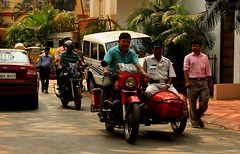 This is one place on earth where I’d be really happy to live: the state of Sikkim in India. And the reason is that by 2015 Sikkim will be completely organic! It will be totally cleansed of all kinds of chemicals—pesticides, synthetic fertilizers and other chemical additives in their farms and gardens. Which means it will have not just chemical-free, clean food, but also chemical-free, clean soil, water and air.
This is one place on earth where I’d be really happy to live: the state of Sikkim in India. And the reason is that by 2015 Sikkim will be completely organic! It will be totally cleansed of all kinds of chemicals—pesticides, synthetic fertilizers and other chemical additives in their farms and gardens. Which means it will have not just chemical-free, clean food, but also chemical-free, clean soil, water and air.
This did not happen overnight. It was a long term plan that the Sikkim state government implemented very methodically over a period of time, designating areas that had to be chemical free by within certain timelines and dates. Bhutan, just north of Sikkim, is still working on becoming the first country to be entirely organic. But I think Sikkim has been more organized and insightful it the planning and implementation of an organic state than Bhutan has been. The Sikkim government kept to its schedule and took the entire population of the state on board, with intensive public outreach, information, education and incentive programs. And by 2015 they will have reached the final leg of their goal and the entire state will be organic, and officially declared so.
Having been a conservation biologist, I am acutely aware of the long term damage that chemicals added to the soil do not only to the health of humans and other animals, but also to the health of the ecosystem. Chemical dependency for the earth is the same as drug dependency in humans. As Sikkim and other organic farms have discovered, once you start using chemical pesticides and fertilizers, over time they become ineffective and you need more and more and more. And the more chemicals you dump in, the sicker the soil becomes till it just ‘dies.’ It becomes unproductive, a wasteland because you’ve killed all the biotic and living components in it.
Indeed the Sikkim program has progressed because ‘converted’ farmers who used traditional methods of farming for pest control and increase in productivity, like multi-cropping and crop rotation, found that their productivity increased over time, the health of the people living and working on the farms improved, and they saved money on purchase of chemicals. This convinced others to do the same.
I do hope Sikkim becomes a role model for land and resource management, and clean and healthy living for the rest of India. Indeed for the rest of the world. We cannot afford to kill the very planet our lives depend on. We owe it to our children and the generations to come that we leave them a healthy environment to live in.
Also See:
How to Tell if the vegetables you are buying are actually organic https://ritabanerjisblog.wordpress.com/2012/10/16/how-to-buy-organic-vegetables/#more-822
The Lesson I learned about genetically manipulated food from a little Himalayan village https://ritabanerjisblog.wordpress.com/2012/10/22/gm-food-and-my-lesson-from-a-little-village-in-the-doon-valley/
Why the women in the Andes grew 4000 species of potatoes https://ritabanerjisblog.wordpress.com/2010/03/23/why-women-in-the-andes-grew-4000-species-of-potatoes/
http://www.sikkimorganicmission.gov.in/mission-2015/
http://www.theguardian.com/global-development/poverty-matters/2013/feb/11/bhutan-first-wholly-organic-country
















maintenance plants
/ September 14, 2014I enjoy reading a post that can make men and women think. Also, thanks for
allowing for me to comment!